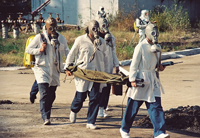 Men are less likely than women to visit the doctor, but men do face several serious health concerns. Learn the top 10 risks as you stay healthy this Father’s Day and all year.
Men are less likely than women to visit the doctor, but men do face several serious health concerns. Learn the top 10 risks as you stay healthy this Father’s Day and all year.
- Accidents and Unintentional Injuries
Men tend to take more risks than women, and that increases their chances of being injured from accidents. Slow down while driving, don’t overestimate your abilities and think before you act as you avoid accidents and unintentional injuries.
- Heart Disease
More than one in three men suffers from a form of cardiovascular disease, according to the America Heart Association. Keep your blood pressure in check, eat a balanced diet, exercise regularly and get routine physicals as you keep your heart healthy.
- Respiratory Diseases
Smoking, asbestos exposure and environmental toxins can lead to respiratory diseases like emphysema, COPD and lung cancer. Stop smoking, eat a balanced diet and avoid environmental triggers as you reduce your risk.
- Liver Disease
The size of a football, your liver digests food, absorbs nutrients and gets rid of toxins. Protect it from cirrhosis and cancer when you avoid alcohol and smoking.
- Diabetes
Anxiety, depression and sexual impotence result from high blood sugar. It can also cause nerve and kidney damage, vision problems and heart disease or stroke if it’s not treated. Exercise and eat a nutrition diet to combat this health risk.
- Prostate Cancer
One in six men develops prostate cancer. It’s not aggressive, but gets regular screenings as you protect yourself.
- Skin Cancer
Men over 50 face a high risk of developing skin cancer. Lower your risk when you wear long sleeves, pants, a hat and sunscreen while working or playing outside, and see your doctor about any suspicious spots.
- Flu and Pneumonia
Flu and pneumonia can affect any man, but it’s more common if you already have a compromised immune system. Get the flu shot and avoid anyone who’s sick as you stay healthy.
- Alcohol
Drinking too much alcohol can lead to chronic illnesses like oral, liver and colon cancer. It also interferes with reproductive health and increases aggressive behavior. Never binge drink, cut down on your alcohol consumption and address any underlying issues like depression that cause you to overindulge.
- Depression As many as six million men suffer from depression, including suicidal thoughts, reports The National Institute of Mental Health. Stay connected to friends, exercise regularly, get enough sleep and seek professional help if you’re struggling with this health challenge.
This Father’s Day, give your loved ones the gift of health when you address the top 10 health risks for men. Visit your doctor for regular physicals, and discuss ways you can get and stay healthy.














